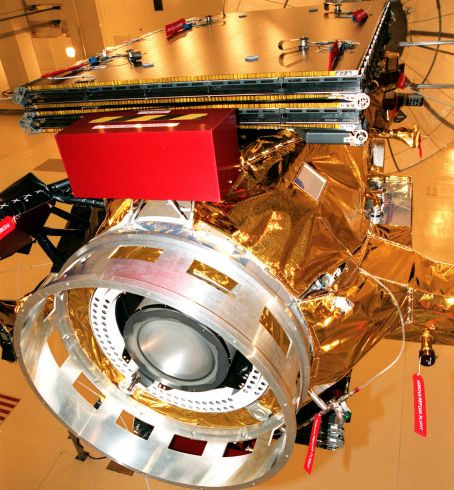Explanation: At full throttle the Deep Space 1 spacecraft's innovative ion drive produces about 1/50th of a pound of thrust ... a force so great that it would just about hold up a piece of paper on planet Earth! Still, powered by solar arrays ion propulsion systems can run continuously. For long duration space missions they ultimately win out over the powerful but brief blasts of less efficient chemical rockets. Deep Space 1 is seen here suspended in an assembly room, a folded solar array resting above the circular ion propulsion module. Already a successful technology demonstrator with experimental autonomous software, the spacecraft flew by asteroid 9969 Braille in July of 1999 but later that year, in November, the robot probe was nearly lost due to the failure of its wide-field star tracker camera. Now, the adventures of Deep Space 1 can continue. Engineers were able to reprogram the navigation system to utilize another on-board camera and on 28 June 2000 the ion drive was throttled up. Once again steering by the stars, Deep Space 1 is presently bound for a September 2001 rendezvous with periodic Comet Borrelly.
1999 2000 2001 2002 2003 2004 2005 2006 2007 2008 2009 2010 2011 2012 2013 2014 2015 2016 2017 2018 2019 2020 2021 2022 2023 2024 2025 |
Январь Февраль Март Апрель Май Июнь Июль Август Сентябрь Октябрь Ноябрь Декабрь |
NASA Web Site Statements, Warnings, and Disclaimers
NASA Official: Jay Norris. Specific rights apply.
A service of: LHEA at NASA / GSFC
& Michigan Tech. U.
|
Публикации с ключевыми словами:
комета LINEAR - spacecraft - ion drive - space
Публикации со словами: комета LINEAR - spacecraft - ion drive - space | |
См. также:
Все публикации на ту же тему >> | |
